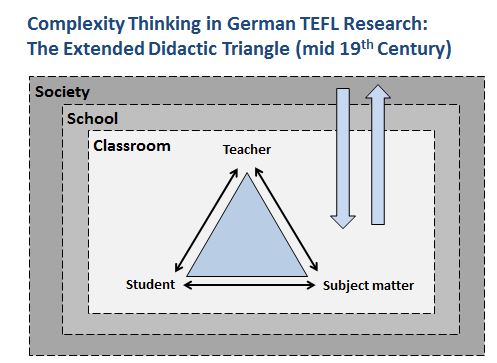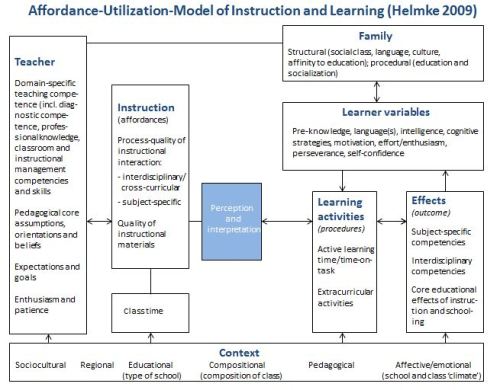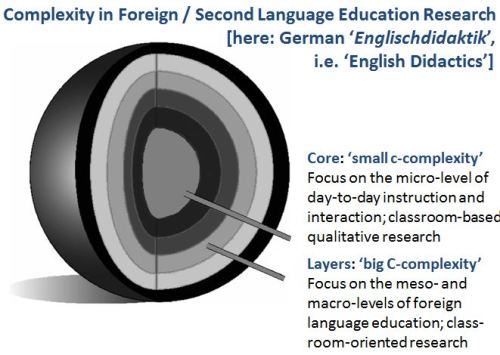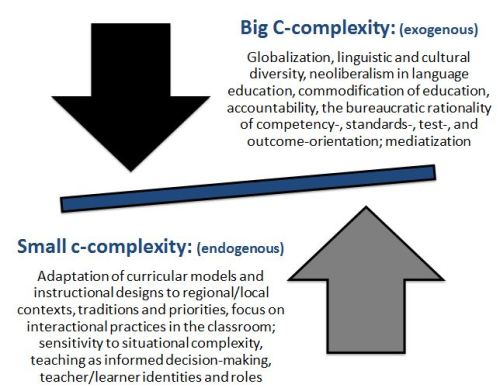posted by Jürgen Kurtz, Justus Liebig University, Giessen, Germany
In a recent publication, Sarah Mercer (2013: 376) states that at present “SLA is undergoing what could be termed a ‚complexity turn’ as researchers become increasingly aware of and sensitive to the inherent complexity and dynamism in learning and teaching foreign languages”. While this may be true for SLA research, it is difficult to generalize across all academic disciplines concerned with foreign language learning and teaching in Europe and elsewhere in the world. I come from a different background – referred to as Englischdidaktik in Germany (English ‘Didactics’).
As an academic discipline, Englischdidaktik is by no means restricted to teaching, and it is not at all to be confused with a didactic, i.e. schoolmasterely chalk-and-talk approach to foreign language instruction built upon simplified assumptions of cause and effect. Rather, Englischdidaktik is a tradition of thinking about and studying teaching and learning that has always been sensitive and fully aware of the complexities, the richness, and the dynamic and emergent character of language pedagogical encounters, as well as the messy nature of foreign language learning. This does not mean, of course, that teachers and teaching should be messy, too. Teaching is more than setting the conditions for learning, because this would be a teaching strategy that is largely based on hope, not more than that. At its core, teaching is highly complex, professional decision-making, before, during, and after instruction, in order to increase the probability of learning.
One traditional heuristic for modeling complexity in general pedagogy and in foreign language learning and teaching in Germany is the ‘Extended Didactic Triangle’ (see below). Developed in the mid 19th century its origins are unclear, but the model nevertheless identifies three core components of any instructional system: student, teacher, and content (see the three corners of the triangle and the three vertices as well). Each of these components is immensely complex itself (various learner and teacher variables, etc.), and all components are interrelated in a complex, nonlinear, and dynamic way. Furthermore, they are embedded in a multi-layered societal and cultural context:
This diagram depicts the beginnings of complexity thinking in Germany. A more recent approach to complexity is, for instance, Andreas Helmke’s ‘Affordance-Utilization-Model of Instruction and Learning’ (2009; my translation) which illustrates how many interconnected factors can actually play a role in the classroom:
However, in current research conducted in the field of Englischdidaktik in Germany a further, pragmatically motivated distinction is typically being made between classroom-based and classroom-oriented research, i.e. between studies that focus primarily on aspects of big C-complexity or small-c complexity, depending on the specific interests and questions of the individual researcher. Studies that focus on small-c complexity are typically conducted in the foreign language classroom (i.e. in many different ways, ranging from qualitative to quantitative, from ethnographic to experimental, employing different research methods, including participatory action research, design experiments, etc.). Studies dedicated to big-C complexity are usually representative of theoretical, rather than empirical research. However, this does not mean that conceptual (‘armchair-‘) research is less complex and important.
I think that in the present age of competency-oriented and standards-based foreign language instruction, increasing attention needs to be given to big-C complexity (not only in Englischdidaktik-research) and how it influences or even shapes everyday classroom practices (in terms of backwash effect):
I also think that the delicate balance between big-C issues (outcome orientation) and small-c issues (process orientation) is at risk currently, not only in Germany:
This is why researchers working in the field of Englischdidaktik and in its international sister disciplines need to step up their efforts to further investigate the complex relation between outcome-orientation (focusing on predictability, this way reducing complexity) and the highly complex processes involved in target language learning and teaching (which are difficult to anticipate).
References:
Helmke, Andreas (2009). Unterrichtsqualität und Lehrerprofessionalität. Diagnose, Evaluation und Verbesserung des Unterrichts (3rd ed.). Seelze-Velber: Klett-Kallmeyer.
Mercer, Sarah (2013). “Towards a Complexity-Informed Pedagogy for Language Learning. Uma proposta de pedagogia para aprendizagem de línguas na perspectiva da complexidade”. RBLA, Belo Horizonte, v. 13, n. 2, p. 375-398, 2013.






